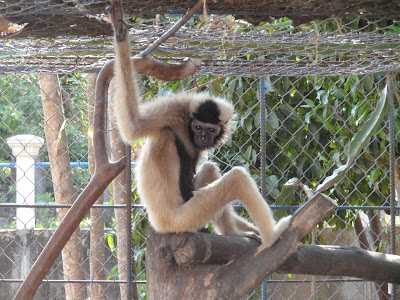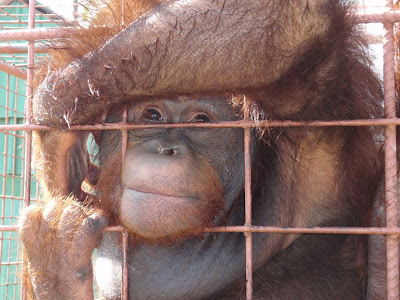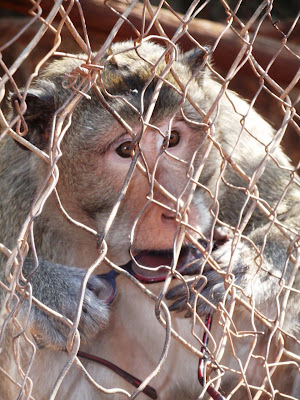Kampot is a sleepy little town about hour and ½ from Sihanoukville.
Our reason for visiting Kampot was to check out Bokor National Park, but we had an afternoon to kill before going so we decided to check out the local zoo. Admission for locals is only $1, but as usual we were treated to a "foreigner discount" at the inflated price of $4 / person. (we like to think of it as "out of state tuition")
We weren’t quite sure what to expect - Cambodia is a third world country and Kampot is a tiny town - but we figured it would be a nice way to spend the afternoon. And I have to say it was something that I never could have imagined.
The first thing we saw when we entered the zoo was the crocodile pond. It was actually a pretty good viewing area for crocs, a large pond with a viewing platform extending out over the water, and was full of the reptiles, both big and small.
a bunch of baby crocs
But in addition to the crocodiles it was also full of trash, mostly plastic bottles and styrofoam containers. Unfortunately, this is par for the course here in Cambodia. The crocodiles didn’t seem to mind it too much, but it can’t be a good reflection on how well the animals here are taken care of here. After checking out the crocodiles for a couple of minutes we moved on, eager to see what else was living in the zoo. Our next stop was the orangutan cage, and it was amazing. Well the cage wasn’t amazing - it was just a cage made of rebar and metal wire – but how close we were able to get to them was just incredible.
There was a fence about a foot away from their cage to keep people from getting too close, but even without leaning over it or fully extending your arm, it was possible to reach out and touch them.
The orangutans were clearly used to human interaction, and as soon as we walked up to their cage they started reaching their hands out. At first we thought they just wanted to touch us, but then we realized that they were asking for a handout. I took the opportunity to touch their hands a couple of times and I was amazed by how much their hands looked and felt like mine.
Of course their hands are rougher than mine, the skin was a bit more leathery, and of course they were hairier, but they looked just like human hands. Their mannerisms were just like ours as well. I was just blown away by how human they seemed.
I was so struck by how similar they looked to us humans that I could barely pull myself away from their cage. Neil and Claire went and picked a mango and gave it to them to eat. Then Neil passed a water bottle over to offer the orangutan a drink.
I was sad to see such intelligent and amazing creatures in such a small and boring cage, but at the same time I was thrilled to be able to be so close to them. I was mesmerized by them.
After the orangutans, we moved on to see some smaller monkeys

Because these monkeys are smaller, their cage was made out of chain-link fence instead of rebar. There wasn’t any fence to keep the humans at a safe distance, so you could get as close to their cage as you wanted AND there were places in the cage with holes big enough for a human hand to reach in. As a result, the cage – like the orangutans’ and crocodiles’ –had wrappers and other human refuse strewn about inside. After the orangutans, we moved on to see some smaller monkeys

my hand reaching into the monkey cage
a small boy feeding the monkey bananas through a hole in the cage
By the time we reached the third cage of monkeys, I was a bit on a monkey high. I was fascinated by how human they seemed and amazed by the fact that I could reach out and (cautiously) touch them. I was worried that the monkeys would try to grab my camera, so I had its strap firmly wrapped around my wrist, but I didn’t worry too much about getting close to their cages, and I guess I went a bit too far.
Just as I was trying to get a super zoomed-in picture of one of the small monkeys,
another monkey reached out and snatched my glasses right off my face. He was so fast that I didn’t even realize what happened until he had already run off with them. At first he tried to wear them properly, but after he realized that wasn’t working for him, he resorted to chewing on them.
As Nick went to look for help, a crowd gathered and tried to get my glasses back. A couple of people tried to trade with the monkey – a banana for my glasses – but he wasn’t interested at all and mostly just kept on chewing. One little girl even threw a rock at the monkey, trying to get him to drop my glasses.
Maybe because it was a Sunday or maybe because it is a horribly underfunded zoo, there were no proper zoo keepers on the grounds. The only person available to help us was the person who worked at the front gate. After about 5 minutes, he walked up carrying a huge stick in his hands. As soon as all the monkeys saw him they ran away scared. You could tell this was not the first time they had seen that stick. The monkey with my glasses, however, aggressively jumped at the man in retaliation.
As it became clear that the zookeeper was going to open the cage and reach right in, everyone got a bit nervous. The monkeys were wildly running about their cage and the crowd of about 10 people started moving away, afraid that once he opened up the cage the monkeys would run out and attack us.
As he opened the cage he thrust his stick in and waved it about. The monkeys, clearly aware that this person was prepared to smack them if they came too close, promptly retreated to the back of the cage. Fortunately, the monkey thief dropped my glasses within reach of the cage door, so the man with the stick just reached right in a grabbed them. It was clear that this was not the first time something like this had happened.
Needless to say, I was a bit shaken up after this and was sure to keep my distance from the rest of the animals. But I just couldn’t believe how close you were able to get to all of them. It was possible to touch virtually any animal in the zoo that would get close enough to let you.
feeding the elephants bananas
And it was clear that the animals have taken their fair share of abuse in the past. Some of them were very aggressive. As I paused to take a picture of one bird, he puffed up and took on an attack posture that had me quickly walking away from his cage. One of the storks even poked his beak about a foot out of his cage and nipped at Neil. a stork giving Neil the evil eye
It was a surprisingly full zoo. They even had a young tiger and two small lion cubs (which we worried may have been procured using questionable methods…) Clair really wanted to touch the lions and she really could have if she just reached her hand out a bit, but Nick and I were strongly discouraging her from doing it. Of course they probably wouldn’t have hurt her, they were very young, but it still can’t be a good idea to have all these people reaching in and touching these wild animals.
notice the water bottle in the cage with the lions...
On our way out of the zoo, we passed by the orangutans one last time and saw that they had something interesting in their hands. It was a plastic bag that looked like it had some meat or something inside it.
But on closer inspection, we realized that someone had given them a bag full of tootsie rolls!!
And a couple minutes later, some local families came over and handed over a bag of chips and another bottle of water. I’m afraid to think of all of the things that people have given them to eat!
an orangutan looking startlingly human
I have to say, our visit to this zoo was one of the most bizarre experiences we've had thus far. It was certainly memorable being so close to all of these animals – especially the monkeys - but like many of my experiences in Cambodia it leaves me perplexed. Should we really be supporting these kinds of institutions?
























No comments:
Post a Comment